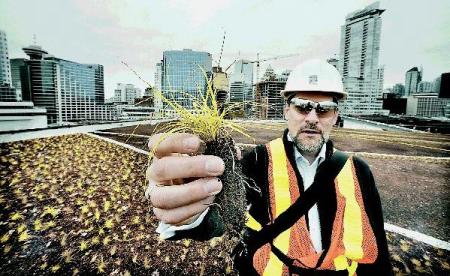City’s Signature Roof
Pete McMartin
Sun

A panoramic view of the convention centre roof, with Coal Harbour and Stanley Park in background. Photograph by : Bill Keay, Vancouver Sun

Landscape architect Bruce Hemstock, with rows of plants ready to go on the roof of the convention centre. Photograph by : Bill Keay, Vancouver Sun

When completed, the roof on Vancouver’s new convention centre will be the greenest in Canada. Still in the development stage, it’s scheduled to come into full bloom in August. Photograph by : Bill Keay, Vancouver Sun

Bruce Hemstock, landscape architect for Vancouver’s convention centre roof, holds plant that forms part of the roof’s covering. Photograph by : Bill Keay, Vancouver Sun
At the moment, the grandest and most ethically ambitious architecture in the city — the green, living roof of the new convention centre — resembles a hair plug job. There’s a lot of bald up there.
It’s sparse, but growth proceeds. They started planting it two weeks ago, and crews are working their way across the six-acre roof sewing and digging in more than 750,000 plants. A green blush appeared on the canvas of the roof’s dark-brown growing medium of pumice and organic matter.
It’s hairing up.
They aren’t plants you find in the typical urban garden. They’re not gaudy flowers, but tough, mundane survivors. There is common thrift and Hooker’s onion and chamiso sedge. There is beach strawberry and broad-leafed stonecrop and silverweed. There is bent grass and pearly everlast and quatro sheeps fescue. All of them are indigenous to B.C.
They’ve been planted about six inches apart on a predetermined grid, and the plan is that by August, they will have grown together to cover all the bare spots and form a dense green, foot-tall mat of vegetation. When it’s complete, it will be the largest green roof in Canada. For something so low-lying and organic, it’s a very big architectural statement — an enormous verdant horizontal in the midst of a vertical downtown.
More than the new convention centre itself, more than the sails of the old convention centre or the stockade of highrise condos ringing Coal Harbour, the roof will be the signature architecture of all those things Vancouver wishes itself to be — green, environmentally compatible and living. It’s the imagined future — not green like Stanley Park, but an attempt to let the rough edges of the wild leak into the urban setting. It will be a little unkempt, and an extension of that which presses up so close to the city.
“The theme of this roof,” said Bruce Hemstock, the roof’s landscape architect, “is B.C. coastal grassland. And I say that sort of loosely because it’s difficult to recreate a coastal grassland on a roof. But esthetically, that’s what we’re going after.
“Practically, did we take coastal grassland plants and put them on the roof? No, because they’re completely different ecologies. But we tried to create a roof that looks like that and functions like that.”
The template, Hemstock said, was Triangle Island, a craggy Gibraltar-like rock at the northern tip of Vancouver Island. It’s a bird colony for murres and puffins, and shawled in a blanket of tough, low-lying greenery. It’s exposed to wind and salt air and rain and hard summer sun, all the environmental challenges that the plants on the roof will face. It’s tough growing up in the wild: it might be tougher in the city.
Hemstock has no doubt the roof will be a success, though some doubts about its viability have been expressed. Nothing this big in Canada has been attempted, and if the roof greenery does fail to take — and for such a wide expanse, the harsh environmental factors of drought, wind and salt air will be all that much more difficult to address — then fixing it will be no easy matter. Or cheap. You can’t just re-tar a green roof.
But Hemstock sees no reason why it shouldn’t. All the plant types have been tested in similar conditions for hardiness. An irrigation system, using the grey water from the convention centre itself, and recycled rain water captured by drains on the roof, will be used to get the plants through periods of drought.
And at fruition, Hemstock sees an ecosystem that will help cool the building during summer, and keep it marginally warmer during the winter. It will greatly reduce the “heat island” effect that conventional roofs contribute to in urban settings. It will extend the life of the roof by shielding it from ultraviolet rays. It will produce oxygen and absorb pollutants. It will muffle the sound of float planes. It will provide a home to nesting songbirds and colonizing insects. It will also be a helluva lot less ugly to look at. If all goes well.
Maintenance?
Weeding crews and weed whackers. There is a limit to the roof’s shagginess, Hemstock said, and when the grasses reach a foot and a half or so, it’ll get a haircut.
But the one big irony of the green roof?
Few will see it. It’s 10 stories above the street. For safety and maintenance reasons, there will be no public access to it. Office workers and residents in the highrises around the convention centre will look down on it, and conventioneers will only be able to see smaller portions of it where lower levels of the roof have been planted.
For the man on the street, whose tax dollars paid for it, the roof will remain a feel-good idea, not a visible tangible. The grandest and most ambitious architectural statement in the city will be unseen.
The plants, and the birds and insects that live there, will have the place to themselves.
© The Vancouver Sun 2008
